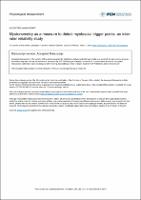Por favor, use este identificador para citar o enlazar este ítem:
https://repositorio.usj.es/handle/123456789/1037
| Título : | Myotonometry as a measure to detect myofascial trigger points: an interrater reliability study (ACCEPTED MANUSCRIPT) |
| Autor: | Jiménez Sánchez, Carolina

Ortiz Lucas, María 
Bravo-Esteban, Elisabeth 

Mayoral-del Moral, Orlando 
Herrero Gállego, Pablo 


Gómez-Soriano, Julio 


|
| Palabras clave : | Muscle stiffness; Myofascial tissue; Myotonometer; Isokinetic dynamometer |
| Fecha de publicación: | 26-nov-2018 |
| Editorial : | Institute of Physics and Engineering in Medicine. |
| Citación : | C Jiménez-Sánchez et al 2018 Physiol. Meas. 39 115004 |
| Resumen : | Objective: Several diagnostic methods have been used in the identification of mechanical properties of skeletal muscle, including myofascial trigger points (MTrPs), but not suitable for daily clinical use. Myotonometry offers an easy noninvasive alternative to assess these muscle properties. Nevertheless, previous research has not yet studied the mechanical properties of MTrPs by myotonometry. The purposes were (1) to analyze differences in the mechanical properties between latent MTrPs and their taut bands by myotonometry, (2) to investigate the inter-rater reproducibility of myotonometric measurements and (3) to examine the association between myotonometry and passive isokinetic dynamometry. Approach: Fifty individuals (58% male; age 24.6±7.9 years) with a latent medial MTrP of the right soleus muscle participated. Mechanical properties of this MTrP area of soleus muscle and its taut band area were measured using a myotonometer (MyotonPRO). Additionally, passive resistive torque and extensibility of triceps surae muscle was assessed using a Kin-Com dynamometer. Main results: Statistical analysis indicated higher values for stiffness parameter in the taut band with respect to MTrP (P<0.05). The inter-rater reliability of the myotonometric measurements was good for all variables (ICC3,1>0.75). Standard error of measurement (SEM) and minimal detectable difference (MDD) indicated small measurement error for frequency and stiffness variables (SEM%<10%; MDD95%<20%). Significant fair correlations between myotonometric parameters and passive isokinetic parameters were ranged from -0.29 to 0.48 (P<0.05). Significance: The myotonometer was demonstrated to be a reliable tool and was able to quantify differences in the mechanical properties of myofascial tissues. The potential of this method for the assessment of myofascial pain syndromes requires further investigation. |
| URI : | https://repositorio.usj.es/handle/123456789/1037 |
| ISSN : | 1361-6579 |
| Aparece en las colecciones: | Artículos de revistas |
Ficheros en este ítem:
| Fichero | Descripción | Tamaño | Formato | |
|---|---|---|---|---|
| Acepted Manuscript Myotonometry as a measure to detect myofascial.pdf | 718,24 kB | Adobe PDF |  Visualizar/Abrir |
Este ítem está sujeto a una licencia Creative Commons Licencia Creative Commons

